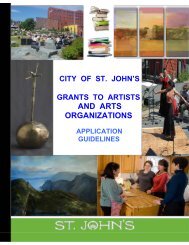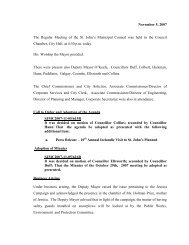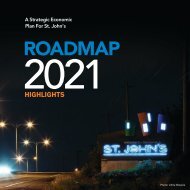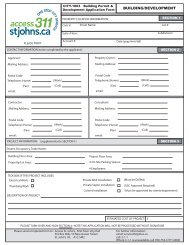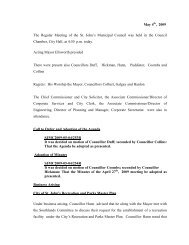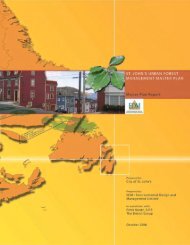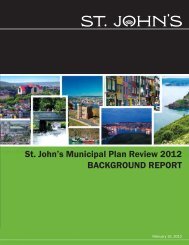Metrobus Transit Study.pdf - City of St. John's
Metrobus Transit Study.pdf - City of St. John's
Metrobus Transit Study.pdf - City of St. John's
You also want an ePaper? Increase the reach of your titles
YUMPU automatically turns print PDFs into web optimized ePapers that Google loves.
<strong>St</strong>. John’s Transportation Commission (<strong>Metrobus</strong>) 2011<br />
Market Assessment and <strong>St</strong>rategic Directions <strong><strong>St</strong>udy</strong> – Part B: The Past and Present – Understanding Ridership Trends<br />
in an aging society is lower as the labour force is generally comprised <strong>of</strong> the 20 to 60 year old<br />
population.<br />
The senior population tends to be more dependent on transit than other age groups and requires<br />
different services, forms <strong>of</strong> service delivery, and levels <strong>of</strong> service. It is important for <strong>Metrobus</strong> to<br />
fully understand the needs <strong>of</strong> this age group and proactively cater to them.<br />
Household Formation versus Population Growth<br />
Household formation in <strong>St</strong>. John’s is occurring at a faster rate than population growth. This means<br />
that the number <strong>of</strong> occupants per household is getting smaller. This is a result <strong>of</strong> two factors:<br />
<br />
An older population creates more households than a younger population as ‘empty nest’<br />
and single person households increase dramatically; and<br />
The declining birthrate reduces the number <strong>of</strong> children per household.<br />
A third factor is the growth in prosperity in recent years in Northeast Avalon. In periods <strong>of</strong><br />
prosperity more young people tend to move out <strong>of</strong> their family home and many have moved to<br />
peripheral locations where the cost <strong>of</strong> housing is less expensive. This trend contributes to transit<br />
ridership decline.<br />
Birthrate<br />
The birthrate in <strong>St</strong>. John’s has been decreasing. <strong>St</strong>udents are a big part <strong>of</strong> transit ridership as they<br />
<strong>of</strong>ten have no other means <strong>of</strong> getting to/from school. The declining number <strong>of</strong> school aged children<br />
is contributing to <strong>Metrobus</strong>’ ridership decline.<br />
6.5 Factors Influencing Auto Ownership and Use<br />
Auto Ownership<br />
Auto use is inversely proportional to transit ridership. Generally, in times <strong>of</strong> economic prosperity<br />
auto use tends to increase and <strong>St</strong>. John’s recent economic boom as a result <strong>of</strong> the oil industry is<br />
reflected in increased auto use. According to a recent issue <strong>of</strong> Moneysense Magazine, <strong>St</strong>. John’s<br />
ranks sixth in the percentage <strong>of</strong> new cars on the road out <strong>of</strong> 178 communities in Canada. This is<br />
ahead <strong>of</strong> Toronto, Vancouver, Calgary, and Montreal, the major centres <strong>of</strong> population in Canada.<br />
Since 2007, it can be inferred that more residents are able to own and operate cars and that this<br />
trend has had a negative impact on <strong>Metrobus</strong> ridership.<br />
According to the CUTA <strong>Transit</strong> Vision 2040 report, transit fares are increasingly expensive<br />
compared to automobile use. <strong>Transit</strong> fares in Canada have been rising faster than inflation and have<br />
increased by 25 percent in real terms over the past decade.<br />
Parking Supply and Price<br />
The <strong>St</strong>. John’s Downtown Development Commission completed a Downtown Parking <strong><strong>St</strong>udy</strong> in<br />
2009 that analysed the existing parking supply and pricing and outlined a Parking Management Plan<br />
based on Downtown growth and anticipated parking demand. This report found that on weekdays,<br />
on-street parking utilization peaks at 80 percent while <strong>of</strong>f-street parking utilization peaks at 61<br />
percent. On street utilization is 100 percent on the west side <strong>of</strong> Downtown during the weekday<br />
peak. This analysis indicates that on street parking is well used throughout the Downtown area with<br />
some capacity available on the east and in <strong>of</strong>f street facilities/lots. On weekends there is ample<br />
Dillon Consulting Limited Page 35




